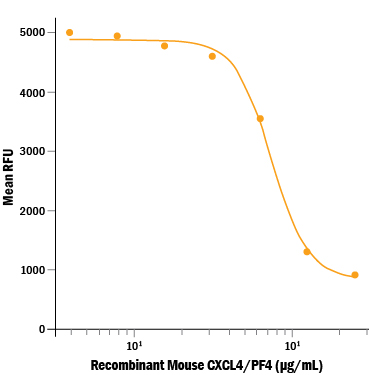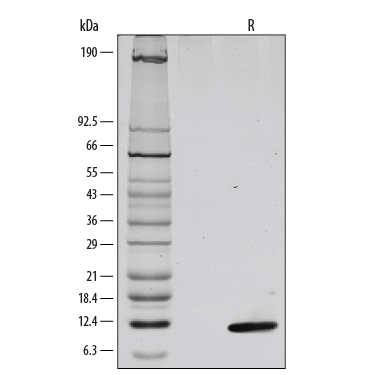Recombinant Mouse CXCL4/PF4 Protein, CF Summary
Product Specifications
Val30-Ser105
Analysis
Product Datasheets
Carrier Free
CF stands for Carrier Free (CF). We typically add Bovine Serum Albumin (BSA) as a carrier protein to our recombinant proteins. Adding a carrier protein enhances protein stability, increases shelf-life, and allows the recombinant protein to be stored at a more dilute concentration. The carrier free version does not contain BSA.
In general, we advise purchasing the recombinant protein with BSA for use in cell or tissue culture, or as an ELISA standard. In contrast, the carrier free protein is recommended for applications, in which the presence of BSA could interfere.
595-P4
| Formulation | Lyophilized from a 0.2 μm filtered solution in PBS. |
| Reconstitution | Reconstitute at 100 μg/mL in sterile PBS. |
| Shipping | The product is shipped at ambient temperature. Upon receipt, store it immediately at the temperature recommended below. |
| Stability & Storage: | Use a manual defrost freezer and avoid repeated freeze-thaw cycles.
|
Scientific Data
 View Larger
View Larger
Recombinant Mouse CXCL4/PF4 (Catalog # 595-P4) inhibits the FGF basic-dependent proliferation of HUVEC human umbilical vein endothelial cells. The ED50 for this effect is 2-10 μg/mL.
 View Larger
View Larger
1 μg/lane of Recombinant Mouse CXCL4/PF4 was resolved with SDS-PAGE under reducing (R) conditions and visualized by silver staining, showing a single band at 10 kDa.
Reconstitution Calculator
Background: CXCL4/PF4
CXCL4, also called PF4 (platelet factor 4), is an 8 kDa member of the CXC chemokine family, sharing features with CXCL8/IL-8 and CXCL7/NAP-2 (1-3). Mature mouse CXCL4 shares 76%, 88%, 64%, 64% and 63% amino acid sequence identity with human, rat, ovine, porcine and bovine CXCL4, respectively. The active protein is a tetramer of CXCL4 subunits that forms a ring of heparin-binding positive charges from sites at the C-terminal region of each monomer (3). Megakaryocytes synthesize CXCL4 and store it in platelet alpha -granules (2, 3). Secretion from activated platelets can produce micromolar levels in serum and over 100‑fold higher within clots (2, 3). In contrast to other CXC chemokines, CXCL4 does not contain an ELR motif and lacks binding to nearly all chemokine receptors (2, 3). A potential high-affinity G-protein-coupled receptor for CXCL4, the CXCR3 isoform CXCR3B, is expressed in human but not mouse (2, 3). In most cases, it is likely that cell surface binding and signaling properties of CXCL4 are due to binding of glycosaminoglycans chains, particularly chondroitin sulfates (2). CXCL4 released from activated platelets binds and regulates thrombin/thrombomodulin complexes, regulates and enhances production of activated Protein C (APC), and limits the coagulation cascade (2-6). It binds and influences the enzymatic activity of coagulation factor Xa (7). It binds fibrin and affects clot structure (8). Therapeutic doses of the anticoagulant heparin neutralize CXCL4 procoagulant effects (9). The complex between heparin and CXCL4 can be immunogenic, and circulating CXCL4-heparin antibodies cause the human syndrome HITT (heparin-induced thrombocytopenia and thrombosis, also called HIT) (2). In addition, immunogenic complexes of CXCL4 with apolipoprotein H can contribute to antiphospholipid syndrome (APS) (10). CXCL4 can be antiproliferative and antiangiogenic, at least in part via interfering with FGF-2 and VEGF heparin binding and thus inhibiting their signaling (3, 11-13). However, it can also be proinflammatory and pro‑atherogenic through multiple effects on monocytes, macrophages and endothelial cells (2, 3).
- Poncz, M. et al. (1987) Blood 69:219.
- Kowalska, M.A. et al. (2010) Thromb. Res. 125:292.
- Slungaard, A. (2005) Int. J. Biochem. Cell Biol. 37:1162.
- Slungaard, A. et al. (2003) Blood 102:146.
- Kowalska, M.A. et al. (2007) Blood 110:1903.
- Preston, R.J.S. et al. (2009) J. Biol. Chem. 284:5869.
- Fiore, M.M. and I.J. Mackie (2009) Biochem. Biophys. Res. Commun. 379:1072.
- Amelot, A.A. et al. (2007) J. Biol. Chem. 282:710.
- Eslin, D.E. et al. (2004) Blood 104:3173.
- Sikara, M.P. et al. (2010) Blood 115:713.
- Perollet, C. et al. (1998) Blood 91:3289.
- Gengrinovitch, S. et al. (1995) Journal of Biological Chemistry 270:15059.
- Sulpice, E. et al. (2004) Eur. J. Biochem. 271:3310.
Citations for Recombinant Mouse CXCL4/PF4 Protein, CF
R&D Systems personnel manually curate a database that contains references using R&D Systems products. The data collected includes not only links to publications in PubMed, but also provides information about sample types, species, and experimental conditions.
5
Citations: Showing 1 - 5
Filter your results:
Filter by:
-
Chemokine-Binding Proteins Encoded by Parapoxvirus of Red Deer of New Zealand Display Evidence of Gene Duplication and Divergence of Ligand Specificity
Authors: S Sharif, N Ueda, Y Nakatani, LM Wise, S Clifton, Z Lateef, AA Mercer, SB Fleming
Front Microbiol, 2019-06-25;10(0):1421.
Species: Mouse
Sample Types:
Applications: Binding Assay -
Platelet Factor 4 Attenuates Experimental Acute Liver Injury in Mice
Authors: HK Drescher, EF Brandt, P Fischer, S Dreschers, RA Schwendene, MA Kowalska, A Canbay, HE Wasmuth, R Weiskirche, C Trautwein, ML Berres, DC Kroy, H Sahin
Front Physiol, 2019-03-26;10(0):326.
Species: Mouse
Sample Types: Whole Cells
Applications: Bioassay -
CXCL4 is a novel nickel-binding protein and augments nickel allergy
Authors: T Kuroishi, K Bando, Y Tanaka, K Shishido, M Kinbara, T Ogawa, K Muramoto, Y Endo, S Sugawara
Clin. Exp. Allergy, 2017-04-21;0(0):.
Species: Mouse
Sample Types: Complex Sample Type, In Vivo
Applications: Bioassay, In Vivo -
Expression of CXCL4 in microglia in vitro and in vivo and its possible signaling through CXCR3.
Authors: de Jong EK, de Haas AH, Brouwer N, van Weering HR, Hensens M, Bechmann I, Pratley P, Wesseling E, Boddeke HW, Biber K
J. Neurochem., 2008-02-01;105(5):1726-36.
Species: Mouse
Sample Types: Whole Cells
Applications: Bioassay -
The role of CCL21 in recruitment of T-precursor cells to fetal thymi.
Authors: Ueno T, Kuse S, Saito F, Nitta T, Kakiuchi T, Hollander GA, Takahama Y
Blood, 2004-09-09;105(1):31-9.
Species: Mouse
Sample Types: Whole Cells
Applications: Bioassay
FAQs
No product specific FAQs exist for this product, however you may
View all Proteins and Enzyme FAQsReviews for Recombinant Mouse CXCL4/PF4 Protein, CF
There are currently no reviews for this product. Be the first to review Recombinant Mouse CXCL4/PF4 Protein, CF and earn rewards!
Have you used Recombinant Mouse CXCL4/PF4 Protein, CF?
Submit a review and receive an Amazon gift card.
$25/€18/£15/$25CAN/¥75 Yuan/¥2500 Yen for a review with an image
$10/€7/£6/$10 CAD/¥70 Yuan/¥1110 Yen for a review without an image

